Converting Your Manuscript to ePub
This week, I endeavoured to convert my dear-god-i-hope-it's-true-second-to-last-manuscript into ePub format so that I could send it to my brother to read on his iPhone and check out how it looks on my iPad. It wasn't really necessary at this point, but I was too excited to see how it looked on the electronically-printed page.The result? It was a little trickier than I expected.First, I tried copying the manuscript over into Storyist and then converting in ePub. Unfortunately, I ran into a number of problems. First, when I copied the text over to the Storyist program using the Past and Match option, it removed all of the italics in the manuscript and altered some of the formatting. This is a problem because in E:CotN, I used italics to denote when the character Blue, who has survived a bullet wound to her throat, speaks in our hollow, whispery voice. Without the italics, the text just doesn't look right. I could copy and paste without matching the formatting but this resulted in text that was too small and inconsistent to be used. I could highlight all of the text and change the font type and size, but this would also remove the italics.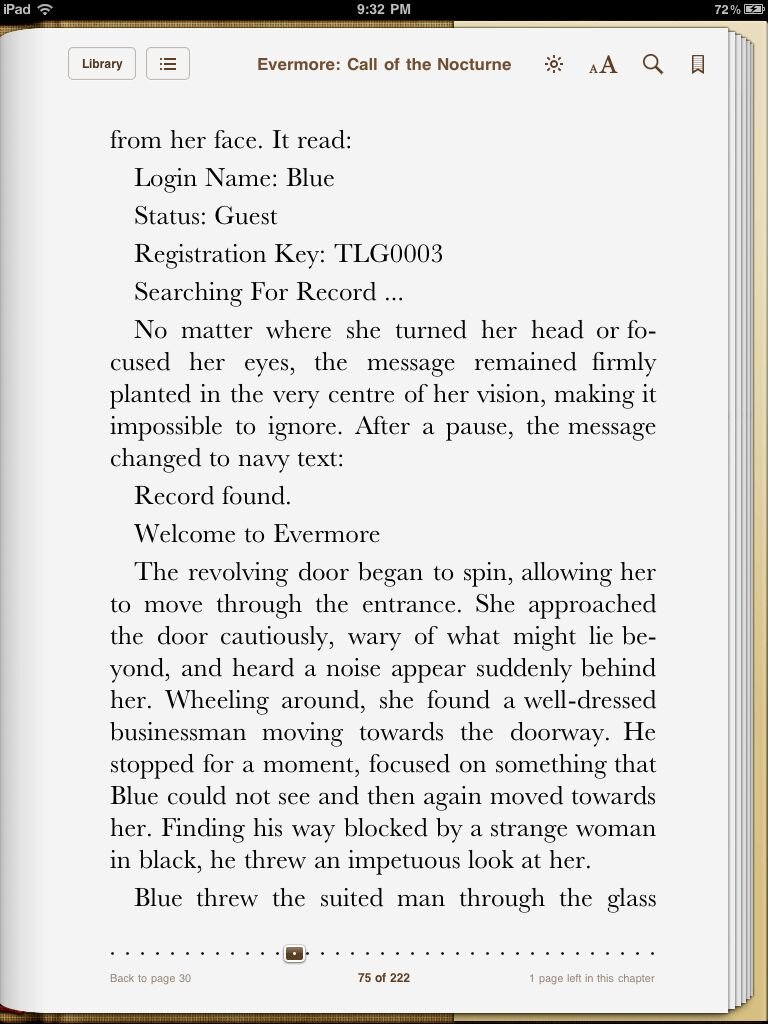 The second problem that I had with Storyist is that when you export a manuscript to .ePub, it adds a little space after each line. Normally, this wouldn't be a problem for me but E:CotN has a lot of very specific formatting for newspaper inserts, song lyrics and computer text. With the extra space added after each line and paragraph, there wasn't enough white space to differentiate between the standard prose and the very specific inserts. There is probably some way to change the settings to remove the extra white space and adjust the formatting, but I was too impatient to attempt it. Instead, I tried converting the manuscript directly from the original .pages file.
The second problem that I had with Storyist is that when you export a manuscript to .ePub, it adds a little space after each line. Normally, this wouldn't be a problem for me but E:CotN has a lot of very specific formatting for newspaper inserts, song lyrics and computer text. With the extra space added after each line and paragraph, there wasn't enough white space to differentiate between the standard prose and the very specific inserts. There is probably some way to change the settings to remove the extra white space and adjust the formatting, but I was too impatient to attempt it. Instead, I tried converting the manuscript directly from the original .pages file.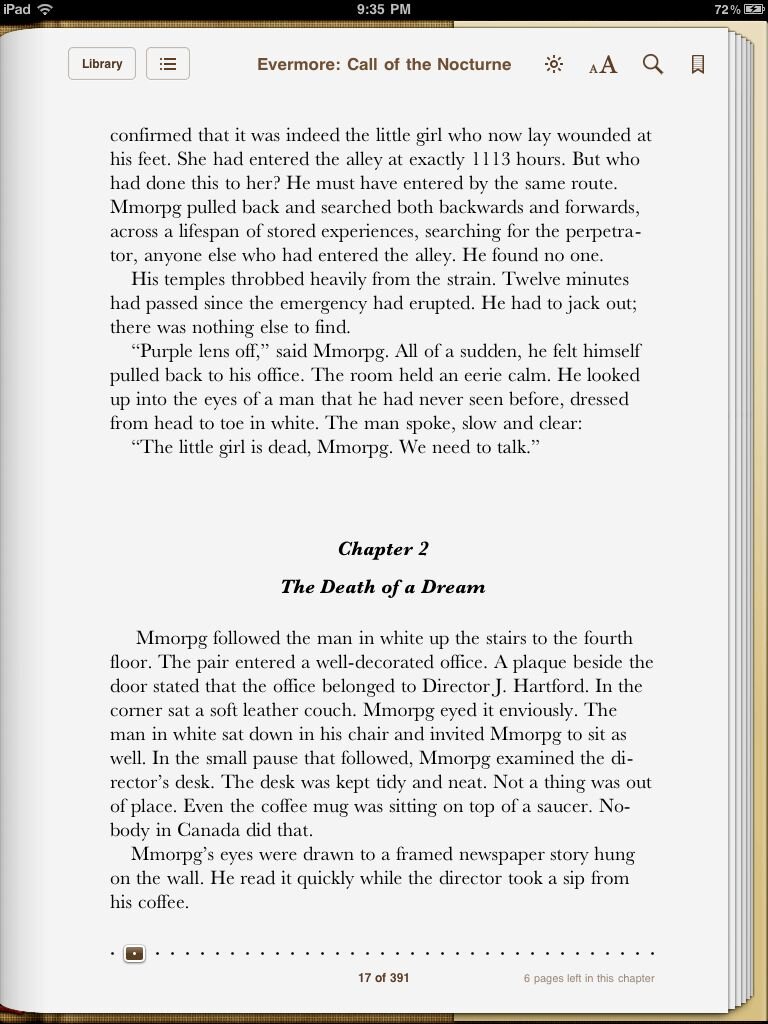 However, Apple Pages had its own challenges that I eventually overcame. First of all, the convertor didn't recognize that I had chapters. The chapter headings that I had created were simply seen as bolded but normal text. So I took the .ePub template file that Apple has provided online, imported the document's styles into my document, and set all of my chapter titles to use the "Chapter Name" style now available in the Inspector.Next I found there was no page breaks between each of the chapters. This was solved by replacing the page break that I had placed in between the chapters with a section break. Finally, I was puzzled by the extra characters that were showing up in the .ePub text. For example, the title of the my first chapter would read: "Chapter 1 - - The Chapter Title". I finally realized that Pages .ePub convertor also converts the markup that has been accumulating since the editing process began. After accepting all of the changes to the document, the problem disappeared.
However, Apple Pages had its own challenges that I eventually overcame. First of all, the convertor didn't recognize that I had chapters. The chapter headings that I had created were simply seen as bolded but normal text. So I took the .ePub template file that Apple has provided online, imported the document's styles into my document, and set all of my chapter titles to use the "Chapter Name" style now available in the Inspector.Next I found there was no page breaks between each of the chapters. This was solved by replacing the page break that I had placed in between the chapters with a section break. Finally, I was puzzled by the extra characters that were showing up in the .ePub text. For example, the title of the my first chapter would read: "Chapter 1 - - The Chapter Title". I finally realized that Pages .ePub convertor also converts the markup that has been accumulating since the editing process began. After accepting all of the changes to the document, the problem disappeared.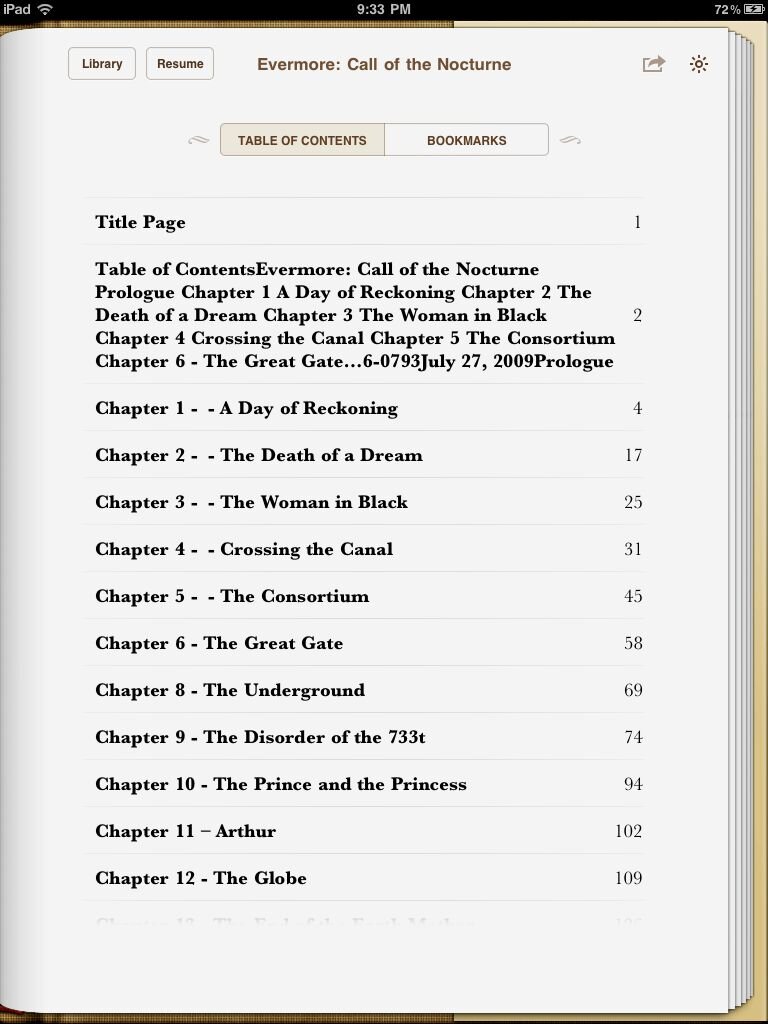 As I grew more confident, I was able to start playing around with the manuscript: setting up the title page to look professional, enlarging the standard text so that it would look just right the first time that it is opened in iBooks, and other experiments with the format. As a result, the text looked exactly how it imagined it on the page. I felt a chill of anticipation run down my spine as I gazed upon my electronic manuscript. It almost looked like a real book, except that it my words.So for the most part, I found Pages easier to use in creating .ePub documents. This is no knock on Storyist, I am certain for my next manuscript that I can produce exactly what I want. But for now, Pages has the edge. It's text simply looks more attractive in .ePub than does Storyist.There are many things that I want to play around with before I publish my novel, including starting each chapter halfway down the page instead of at the top. But for now, this looks good enough.
As I grew more confident, I was able to start playing around with the manuscript: setting up the title page to look professional, enlarging the standard text so that it would look just right the first time that it is opened in iBooks, and other experiments with the format. As a result, the text looked exactly how it imagined it on the page. I felt a chill of anticipation run down my spine as I gazed upon my electronic manuscript. It almost looked like a real book, except that it my words.So for the most part, I found Pages easier to use in creating .ePub documents. This is no knock on Storyist, I am certain for my next manuscript that I can produce exactly what I want. But for now, Pages has the edge. It's text simply looks more attractive in .ePub than does Storyist.There are many things that I want to play around with before I publish my novel, including starting each chapter halfway down the page instead of at the top. But for now, this looks good enough.
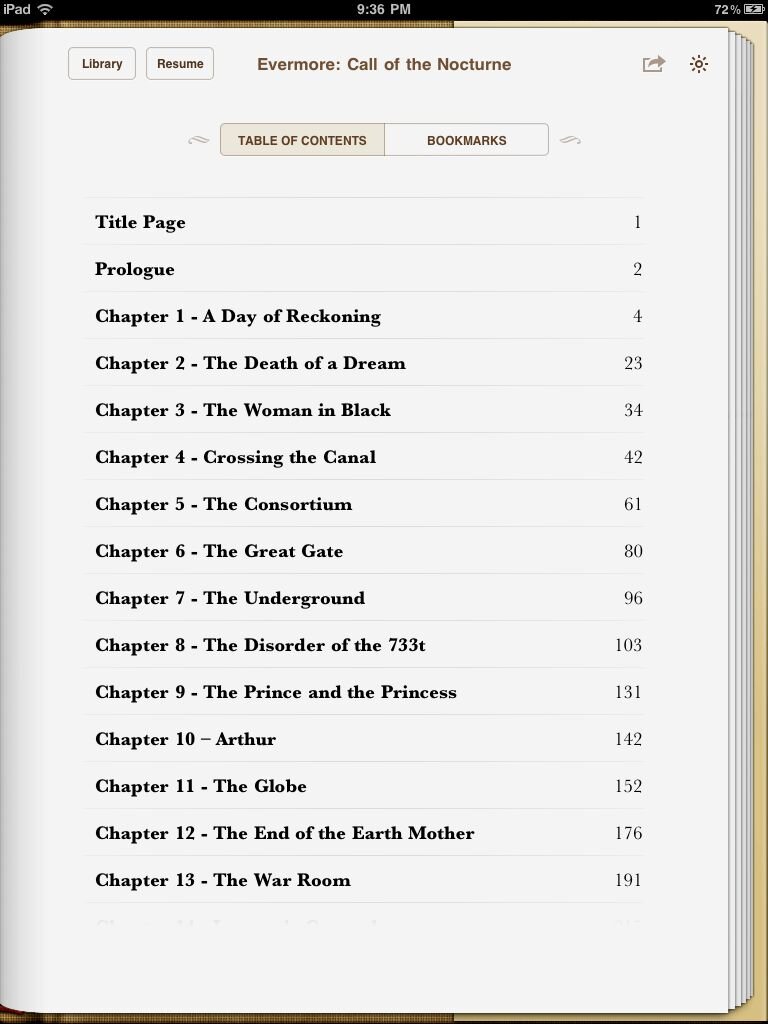
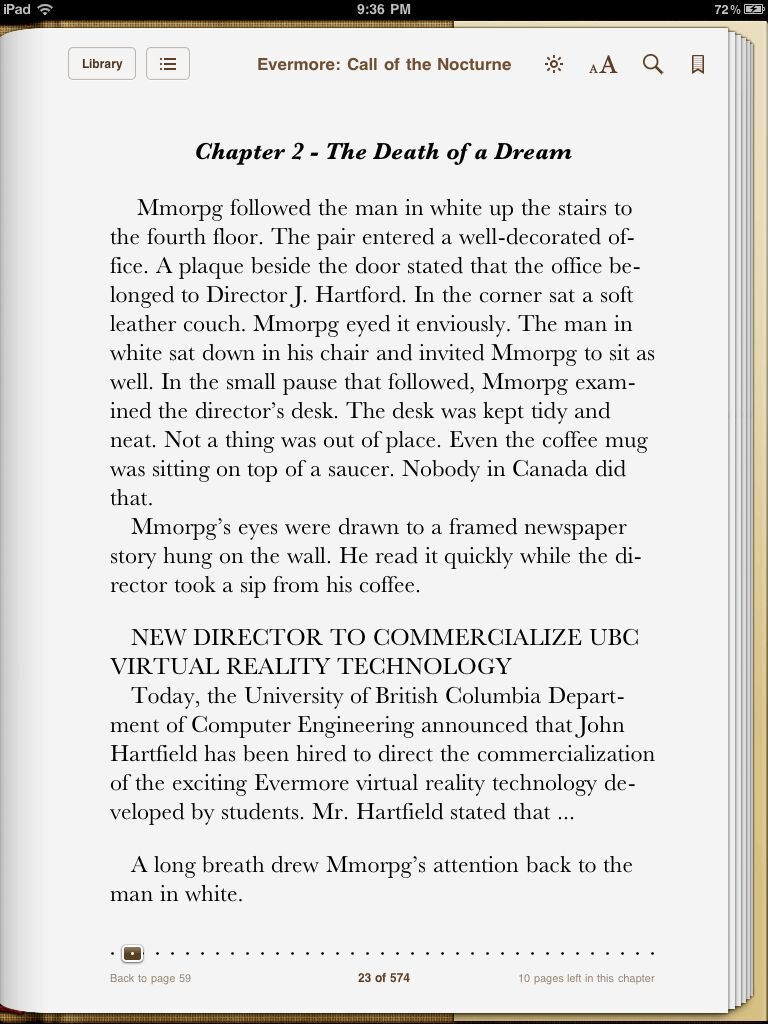
Why I picked Storyist
Over the past few weeks, my writing output has been slowed as I've made to transition from Windows to Mac. When I was on Windows, I would fight my way through MS Word. Word is probably the best word processor on the market, but I found that it got in the way of the writing experience when working on fiction. Far too often I would have to worry about formatting rather than what was happening next in my story. I wrote all of Evermore: Call of the Nocturne on Word and it was a long laborious process.So when my PC died and I made the switch to Mac, I wanted to choose my writing software carefully. Checking the Internet, it seemed that there was only two programs to consider: StoryMill and Scrivener. Far and away the most popular writing programs, StoryMill and Scrivener deserved to be taken head-to-head. So I downloaded their generous demos and got to work.StoryMillThis was my early favourite. Easy to set up, easy to use, StoryMill did a great job of getting out of my way and letting me write. It didn't look the best, especially on Mac, but it got the job done.However, it did have a few annoyances. It's full screen writing mode was an ugly, eye-sore that stretched across my widescreen monitor, making it look like my paragraphs were lonely sentences. Its character section was nice but didn't let me add groups. As my wiki file for the Evermore Trilogy contains characters, groups, things, and locations, this wasn't enough for my purposes. Finally, StoryMill was good but it didn't feel incredible. It didn't make me excited to write. Instead, it felt like a chore.ScrivenerWhile I took StoryMill through its paces, I didn't spend too much time with Scrivener. It looked nice but I could never really get into it. It simply took too long to set up and coordinate in order to facilitate the writing process. It made the whole thing harder rather than easier.Thus, I was all set to buy StoryMill. I was ok with it but I wasn't overjoyed by the product. I felt that it would simply get the job down.Then I heard about Storyist. Storyist caught my attention when I heard that it was the first writing program tha would allow you to directly export to the .epub file format. Curious, I read some reviews. They were enthusiastic about the new version, even more so then StoryMill or Scrivener. So I downloaded the 15-day demo and put it through it's paces.StoryistFirst I tried out the character documentation feature. To my surprise, it allowed me to create groups. Secondly, it put them into an attractive and concise format. After playing with it fo a couple days, I was convinced that it's Story creation features were better than StoryMill and more focused than Scrivener.Next, I transferred over a Novella that I was working on in StoryMill to see how it handled the actual writing. It took some getting used to but soon enough I was writing with far more efficiency than I was used to. Chapters are organized on the left hand side but it also allows you to subdivide the chapters down into sections. I really like this feature as you can create your story as a group of sections and simply move these sections from chapter to chapter as you edit.The full-screen option is another feature that I love. Rather than the ugly wide blue screen of StoryMill or slight translucency of Scrivener, Storyist uses a straight-up manuscript look with black letter boxes. The look is appealing in that when you write the pages go by quickly because of its low word-count per page. This is great because it makes you feel like you're really flying and getting a lot of work done. It's a subtle form of positive reinforcement that really makes the writing experience fun.The only thing that I don't like about the writing with Storyist is the Progress Goal. StoryMill has this great progress meter that allows you to set a daily session goal (say 1000 words) and updates a progress bar as you write. Storyist on the other hand uses an Inspector that you must click to pop up. The Inspector contains other features but its session goal feature leaves a lot to be desired. Unlike StoryMill, the session goal does not reset on every writing session. That means that if you set a goal of 1000 words and finish that goal, when you come back the next day the session goal will not reset automatically. In other words, you have to reset the session goal automatically each and every time you write. This is highly annoying especially when you're used to the ease of StoryMill's progress bar. Hopefully in an update they'll fix this issue.The feature that I love most however is Storyist's ability to export your story to an .epub file. As everyone knows by now, .epub is the format used by Apple's iPad and it also works with the popular Stanza app for iPhone. Storyist allows you to organize your pages and include a cover page from the images section of the navigator pane on the left. The end result looks great in Stanza (I haven't tried it in iPad yet). It's nice and clean and it makes sure there are page breaks for each new chapter. This is something that Smashwords' Meat-Grinder process does not do all, leaving chapter breaks in the middle of the page. The result is a far more attractive file. After you've exported the story to .epub you can still edit it, allowing you to optimize the file for the platform. All in all, it works exactly as it should. It's easy and simple and allows you to do what you need. It makes it a breeze to publish books on the iPhone and iPad.For all the reasons above, I found that Storyist was the best program for my needs on the Mac. I purchased it a couple weeks ago and have made a lot of progress finishing the first draft of my next novella. I would recommend it to anyone. It just makes writing fun.